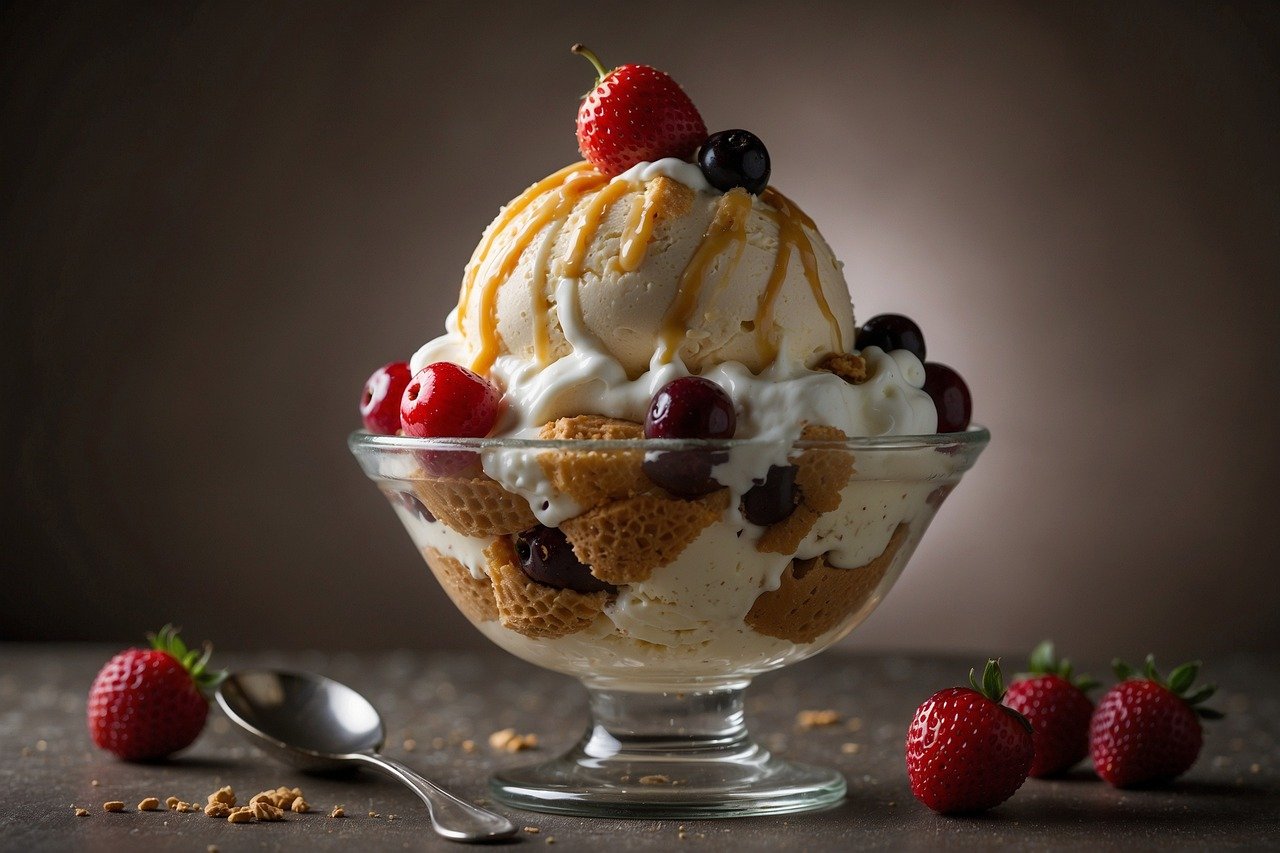Learn how to make ice cream with our step-by-step guide. Discover essential tips, popular recipes, and creative flavor ideas for crafting the perfect creamy dessert at home. Making ice cream at home is a delightful and rewarding experience that lets you craft a treat exactly to your taste.
Whether you’re a fan of classic vanilla, rich chocolate, or adventurous flavors, learning the basics of ice cream making opens up a world of delicious possibilities. With just a few simple ingredients and some basic equipment, you can create smooth, creamy ice cream that rivals anything from the store. This guide will walk you through the science, techniques, and recipes needed to make perfect ice cream right in your kitchen.
Table of Contents
Introduction
What is Ice Cream?
Ice cream is a beloved frozen dessert made from a mixture of cream, milk, sugar, and flavorings, which is churned while freezing to create a smooth and creamy texture. It’s enjoyed by people of all ages and has a versatility that allows for endless flavor variations.
A Brief History of Ice Cream
The origins of ice cream can be traced back to ancient times when flavored snow and ice were enjoyed by the elite in Persia and China. The modern form of ice cream began to take shape in the 17th century in Europe, where recipes using milk, cream, and eggs started to appear. Ice cream became widely popular in America in the 19th century, with advancements in refrigeration making it more accessible.
The Global Popularity of Ice Cream
Ice cream is a universal treat, with every culture putting its spin on this frozen dessert. From Italian gelato to Indian kulfi and Japanese mochi ice cream, the global variations of ice cream are as diverse as the people who enjoy them.
The Science of Ice Cream
The Role of Ingredients
The delicate balance of fat, sugar, water, and air is ice cream. Each ingredient plays a crucial role:
Fat: Fat (from cream or milk) provides richness and a smooth mouthfeel.
Sugar not only sweetens the ice cream but also lowers the freezing point, preventing the mixture from becoming too hard.
Water: Water (from milk) is essential for freezing, but too much can cause ice crystals to form.
Air is incorporated during churning, giving ice cream its light texture.
The Freezing Process: The freezing process of ice cream is critical to its texture. The goal is to create the smallest possible ice crystals, which results in a smoother texture. Rapid freezing and constant churning help achieve this by preventing large crystals from forming.
The Role of Air and Texture
Air is an invisible but important ingredient in ice cream, often referred to as “overrun.” It makes the ice cream lighter and more scoopable. The amount of air added affects the texture: less air results in a denser product (like gelato), while more air creates a lighter texture.
Essential Equipment for Making Ice Cream
Ice Cream Makers
Various types of ice cream makers are available:
Manual Ice Cream Makers: Require hand-cranking but offer a traditional method.
Electric Ice Cream Makers: Make the process easier with an electric motor.
Compressor Ice Cream Makers: These high-end machines have built-in freezers, allowing continuous batches without pre-freezing.
Other Essential Tools
Apart from an ice cream maker, you’ll need:
Mixing Bowls: For combining ingredients.
Whisk: To mix ingredients thoroughly.
Spatula: For scraping the sides of the bowl.
Thermometer: To monitor the temperature of custard-based ice creams.
Ice Cream Scoops: For serving.
Ingredients and Their Functions
Understanding the ingredients will help you make the best ice cream:
Cream and Milk: Provide fat and water, which are essential for texture.
Sugar: Adds sweetness and affects freezing.
Egg Yolks: Used in custard-based ice creams for richness and emulsification.
Flavorings: Such as vanilla, chocolate, fruit purees, and more.
Basic Ice Cream Recipe: How to Make Ice cream
Classic Vanilla Ice Cream
Ingredients:
2 cups heavy cream
1 cup whole milk
3/4 cup sugar
1 vanilla bean or 1 tsp vanilla extract
Pinch of salt
Instructions:
Heat the Milk and Sugar: In a saucepan, combine the milk, sugar, and a pinch of salt. Part the vanilla bean and scratch out the seeds, adding both the seeds and the unit to the blend. Heat over medium intensity until the sugar is disintegrated and the combination is hot yet not bubbling.
Chill the Mixture: Remove from heat and stir in the heavy cream. Let it cool to room temperature, then cover and refrigerate for at least 2 hours or overnight.
Churn the Ice Cream: Remove the vanilla pod from the chilled mixture. Pour the mixture into your ice cream maker and churn according to the manufacturer’s instructions, typically 20-25 minutes.
Freeze: Transfer the churned ice cream to an airtight container and freeze for at least 4 hours before serving.
Tips for Success
Use Cold Ingredients: Starting with cold ingredients helps the ice cream freeze faster, leading to smaller ice crystals and a smoother texture.
Don’t Overfill the Machine: Leave room in the ice cream maker for the mixture to expand as it churns.
Flavor Variations and Add-ins
Popular Ice Cream Flavors
Once you’ve mastered vanilla, the sky’s the limit! Some popular flavors include:
Chocolate: Add cocoa powder or softened chocolate to the base.
Strawberry: Incorporate fresh or pureed strawberries.
Mint Chocolate Chip: Use peppermint extract and chocolate chunks.
Incorporating Mix-ins: Mix-ins like nuts, chocolate chips, or fruit can be added during the last few minutes of churning. This ensures even distribution without affecting the texture of the ice cream.
Creating Your Own Unique Flavors
Experiment with spices, herbs, and unusual ingredients like balsamic vinegar, lavender, or goat cheese. The key is balancing flavors so that no single element overpowers the rest.
Dairy-Free and Vegan Ice Cream
Substituting Dairy Ingredients
There are several dairy substitutes available for making vegan ice cream:
Coconut Milk: Rich and creamy, perfect for mimicking the texture of dairy.
Almond Milk: A lighter option, though you may need to add a thickener.
Cashew Cream: Offers a smooth, neutral base.
Popular Dairy-Free Recipes
Coconut Milk Ice Cream:
2 cans full-fat coconut milk
3/4 cup sugar
1 tbsp vanilla extract
Instructions:
Combine the coconut milk, sugar, and vanilla extract in a saucepan. Heat until the sugar is dissolved.
Chill the mixture in the refrigerator for at least 2 hours.
Stir in an ice cream maker and refrigerator until solid.
Tips for Texture and Flavor
Use Full-Fat Ingredients: Dairy-free ice creams can sometimes turn out icy. Using full-fat coconut milk or adding a bit of alcohol (like vodka) can improve texture.
Sweeten to Taste: Dairy-free bases can have a different sweetness level, so taste the mixture before churning.
Healthier Ice Cream Alternatives
Low-Sugar and Low-Fat Options
You can reduce sugar and fat in your ice cream by:
Using Sugar Substitutes: Stevia, erythritol, or monk fruit sweetener can replace sugar.
Reducing Cream: Substitute some of the cream with more milk or use a low-fat option.
Using Natural Sweeteners
Honey, maple syrup, or agave can be used as natural sweeteners. Keep in mind that they will slightly alter the flavor of the final product.
High-Protein Ice Cream
Protein powders or Greek yogurt can be added to your ice cream base for a healthier, higher-protein treat. This is particularly popular in fitness circles.
Troubleshooting Common Issues
Grainy Texture
Grainy ice cream is often the result of over-churning or not dissolving the sugar completely. To avoid this, ensure your sugar is fully dissolved before churning and stop the machine as soon as the ice cream reaches a soft-serve consistency.
Ice Crystals Formation
Ice crystals form when the ice cream freezes too slowly or when there’s too much water in the mixture. To prevent this, use the right balance of fat and sugar, and ensure your ice cream maker is cold enough before starting.
Too Soft or Too Hard Ice Cream
If your ice cream is too soft, it may not have frozen enough during churning, or it may contain too much sugar or alcohol. On the other hand, if it’s too hard, try reducing the sugar or adding a bit more fat to the recipe.
Serving and Storing Ice Cream
The Art of Scooping
For perfect scoops, let the ice cream sit at room temperature for a few minutes to soften slightly. Use a warm scoop to glide through the ice cream smoothly.
Best Practices for Storage
Store ice cream in an airtight container to prevent it from absorbing other freezer odors. Placing a piece of plastic wrap directly on the surface of the ice cream can also prevent ice crystals from forming.
Creative Serving Ideas
Ice Cream Sandwiches: Use cookies, brownies, or even waffles.
Sundaes: Top with whipped cream, hot fudge, and a cherry.
Milkshakes: Blend with milk for a classic treat.
Conclusion
The Joy of Homemade Ice Cream
Making ice cream at home is not only rewarding but also allows you to control the ingredients and create unique flavors tailored to your tastes.
Encouragement to Experiment
Feel free to try with different ingredients and techniques. Ice cream is a versatile canvas that invites creativity.
Final Tips
Patience is Key: Allowing your ice cream base to chill properly and your ice cream to freeze thoroughly will yield the best results.
Have Fun: The process of making ice cream is just as enjoyable as eating it, so enjoy every step!



